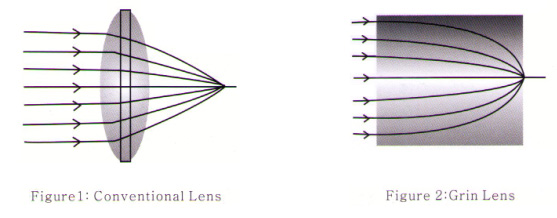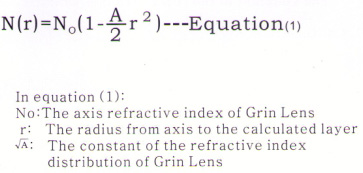Gradient Index Lens is a cylindrical lens, in which the refractive index continuously decreases from the central axis to the peripheral surface. It has the ability to focus, collimate and image.
Characteristics
When encountering the different material in the air, light ray will change its direction due to the different refractive index of the material. The conventional lens redirects light towards a point of focus by controlling the curve of the surface accurately to form the image. (Figure 1)
The difference between Grin Lens and conventional lens is that the material of Grin Lens can refract light continuously that spreads along the radial and reduce the refractive index gradually. In this way, transmission light can be redirected towards the focus point smoothly and continually. (Figure 2)

Grin Lens utilizes the characteristic that the index of refraction of gradient decreases the radial gradually. The variance of refractive index is described by equation 1. Figure 3 illustrates the Grin Lens Refractive Index Profile.


Ray Trajectories of Grin Lens in Various Pitches

General Parameters of Grin Lens
Pitch (P) – In Grin Lens, the light ray transmits along the sinusoidal path. The length of the light finishing a sine wave period is called a pitch.
Length (L) – The length of Grin Lens refers to the distance between the two working surfaces of the length.
Constant (gena ) – The constant of the refractive index distribution of Grin Lens.
Numerical Aperture (NA)
N.A.=nSinam ——- Equation (2)
In equation 2:
n: axis refractive index of grin lens
am: maximum aperture of the incident light
